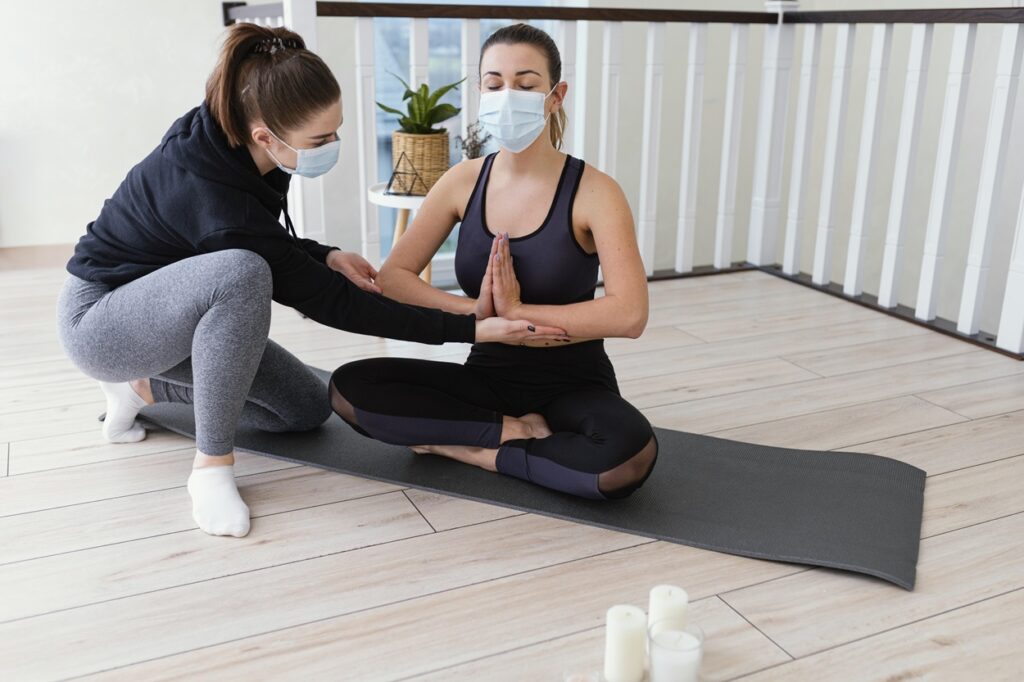Yoga For Injury Rehabilitation:
Yoga, known for its gentle and adaptable exercises, plays a significant role in the recovery and rehabilitation from injuries. Its blend of stretching, strengthening, and mindfulness practices not only aids physical healing but also supports mental well-being during the recovery process. Do people really use yoga for injury rehabilitation and recovery from injury?
Related Article: Muscle Roller Easy Guide: What Is A Muscle Roller And How To Use One?
This article will explore how yoga can be effectively incorporated into injury rehabilitation and the key considerations to keep in mind.

Gentle Stretching for Healing
Yoga’s stretching exercises are particularly beneficial for injury recovery. They help increase blood flow to the injured area, which can speed up healing. Gentle stretches can also prevent stiffness and maintain flexibility in muscles that may not be used as frequently during recovery.
- Examples: Modified versions of Cat-Cow Stretch for spinal injuries or a gentle hamstring stretch for leg injuries.
Strengthening and Stabilizing
Yoga can also help rebuild strength in muscles weakened by injury or surgery. The practice focuses on controlled movements that can be adjusted according to one’s healing process, ensuring a safe strengthening routine.
- Examples: Using poses like Bridge Pose for lower back rehabilitation or Warrior Pose for strengthening the legs and knees.
Mindfulness and Breathwork for Pain Management
The mindfulness and breathwork aspects of yoga are invaluable for managing pain, a common challenge during injury recovery. Techniques like deep breathing and meditation can help manage pain perception and reduce anxiety related to injury and recovery.
- Examples: Pranayama (breathwork) techniques for pain management or guided meditation for relaxation and stress relief.
Yoga for Flexibility and Range of Motion
Yoga’s focus on full-body movement can help restore range of motion that may have been impacted by injury. The gradual and controlled nature of yoga poses ensures that flexibility is regained without putting undue stress on the healing injury.
- Examples: Gentle hip openers for pelvic injuries or shoulder mobility exercises for upper body injuries.
Adapting Yoga for Injury Recovery
It’s crucial to adapt yoga practices to fit the specific needs and limitations of the individual recovering from an injury. This might include using props, modifying poses, or focusing on restorative yoga practices.
- Examples: Using a chair for support in standing poses or a bolster in restorative poses.
Yoga’s Holistic Approach to Recovery
Yoga’s holistic approach addresses not just the physical aspects of injury recovery but also the emotional and mental challenges. The practice encourages patience, self-compassion, and a non-judgmental attitude towards one’s recovery journey.
Consulting with Healthcare Professionals
Before starting or adapting a yoga practice for injury recovery, it’s important to consult with healthcare professionals. This ensures that the yoga routine complements the medical treatment and rehabilitation plan.
Yoga for Emotional Balance During Recovery
Recovering from an injury often comes with emotional and psychological challenges, such as frustration, anxiety, or depression. Yoga, with its emphasis on mindfulness and breath control, can be a powerful tool in managing these emotional ups and downs. Practices like meditation and gentle yoga flow can help maintain a positive mindset, encouraging resilience and a more optimistic outlook during the recovery process.
Tailoring Yoga to Different Types of Injuries
The type of injury dictates the kind of yoga practice that would be most beneficial. For instance, injuries related to overuse, such as tendinitis, require different poses and approaches compared to acute injuries like fractures. A personalized yoga program, ideally developed in consultation with a healthcare provider, can target specific areas and needs, ensuring a safe and effective practice.
Incorporating Restorative Yoga for Healing
Restorative yoga is particularly beneficial for injury recovery. This form of yoga emphasizes relaxation and healing, using props to support the body in passive poses. These poses are held for longer periods, allowing the body to gently stretch and relax without strain, encouraging healing and reducing the risk of re-injury.
Yoga as Complementary Therapy
While yoga can be a valuable part of an injury recovery program, it’s essential to remember that it should be used as a complementary therapy. It works best alongside other rehabilitation methods recommended by healthcare professionals, such as physical therapy, medication, or surgery, depending on the injury.
Yoga Practices and Their Benefits in Injury Recovery
| Yoga Practice | Type of Injury | Benefits |
|---|---|---|
| Gentle Stretching (e.g., Cat-Cow) | Spinal Injuries | Increases blood flow and maintains flexibility |
| Strengthening Poses (e.g., Warrior Pose) | Leg and Knee Injuries | Rebuilds muscle strength and stability |
| Breathwork (Pranayama) | General Pain Management | Helps in managing pain perception and reduces anxiety |
| Restorative Poses (e.g., Supported Child’s Pose) | General Rehabilitation | Promotes relaxation and healing, supports emotional well-being |
| Guided Meditation | Psychological Impact of Injury | Aids in maintaining a positive mindset and emotional balance |
| Hip Openers | Pelvic Injuries | Restores range of motion and flexibility |
| Shoulder Mobility Exercises | Upper Body Injuries | Improves flexibility and function in the shoulder region |
Related Article: Restorative Yoga For Beginners: Simple. Popular. Effective!
Final Thoughts:
Yoga’s role in injury recovery is multifaceted, offering physical, emotional, and mental support. Its adaptability makes it suitable for a wide range of injuries and individuals. By focusing on gentle, controlled movements, breathwork, and mindfulness, yoga can enhance the healing process, providing a nurturing and holistic approach to rehabilitation. Always remember to align your yoga practice with your recovery goals and consult healthcare professionals to ensure the safest and most effective approach.
References:
https://sportsmedicineweekly.com/sports/yoga-for-injury-recovery/




